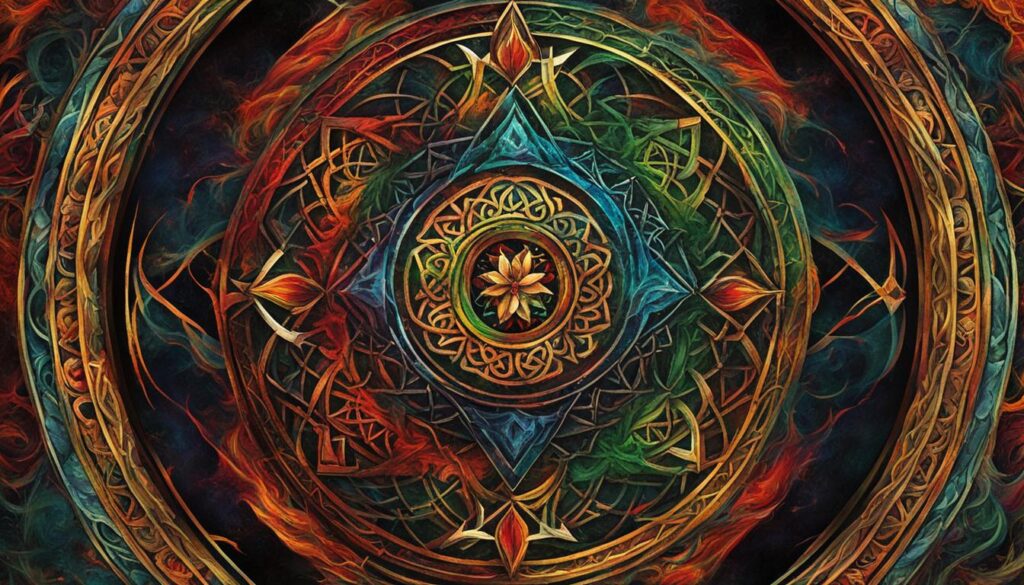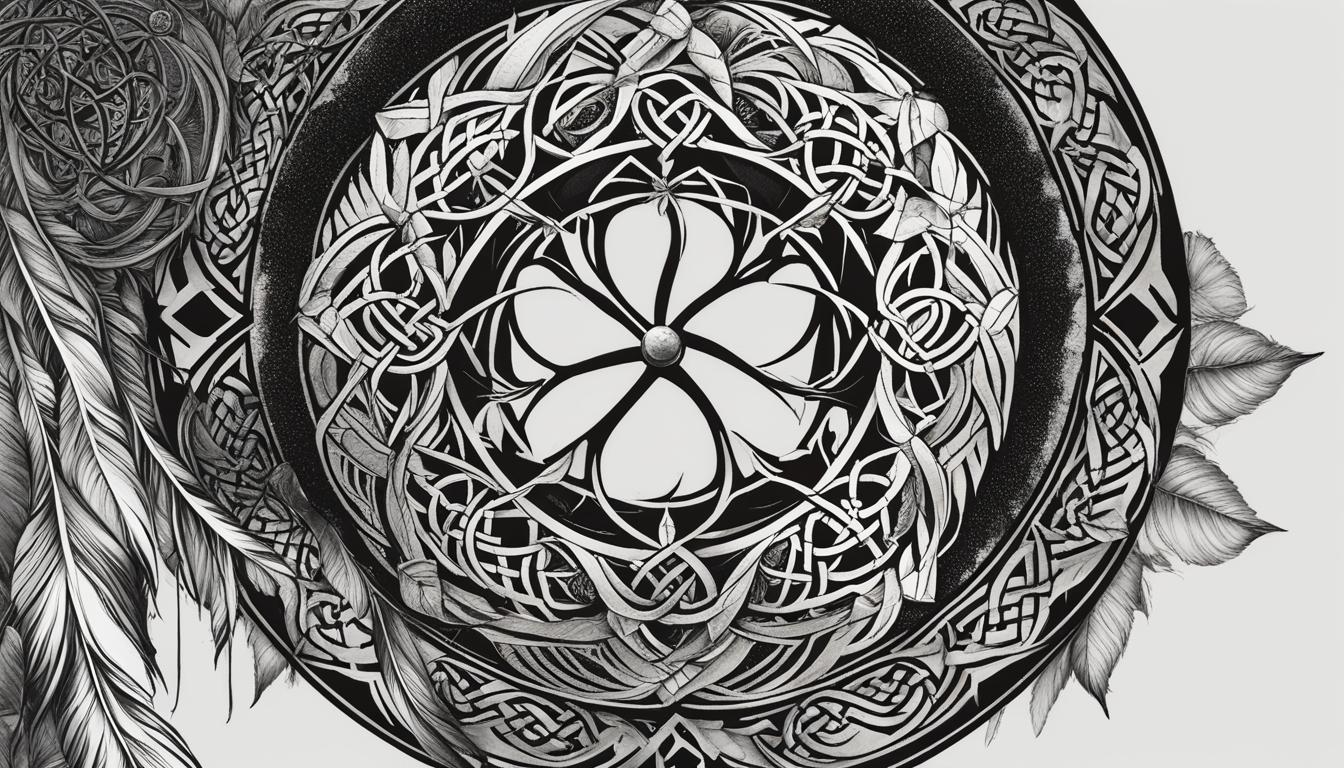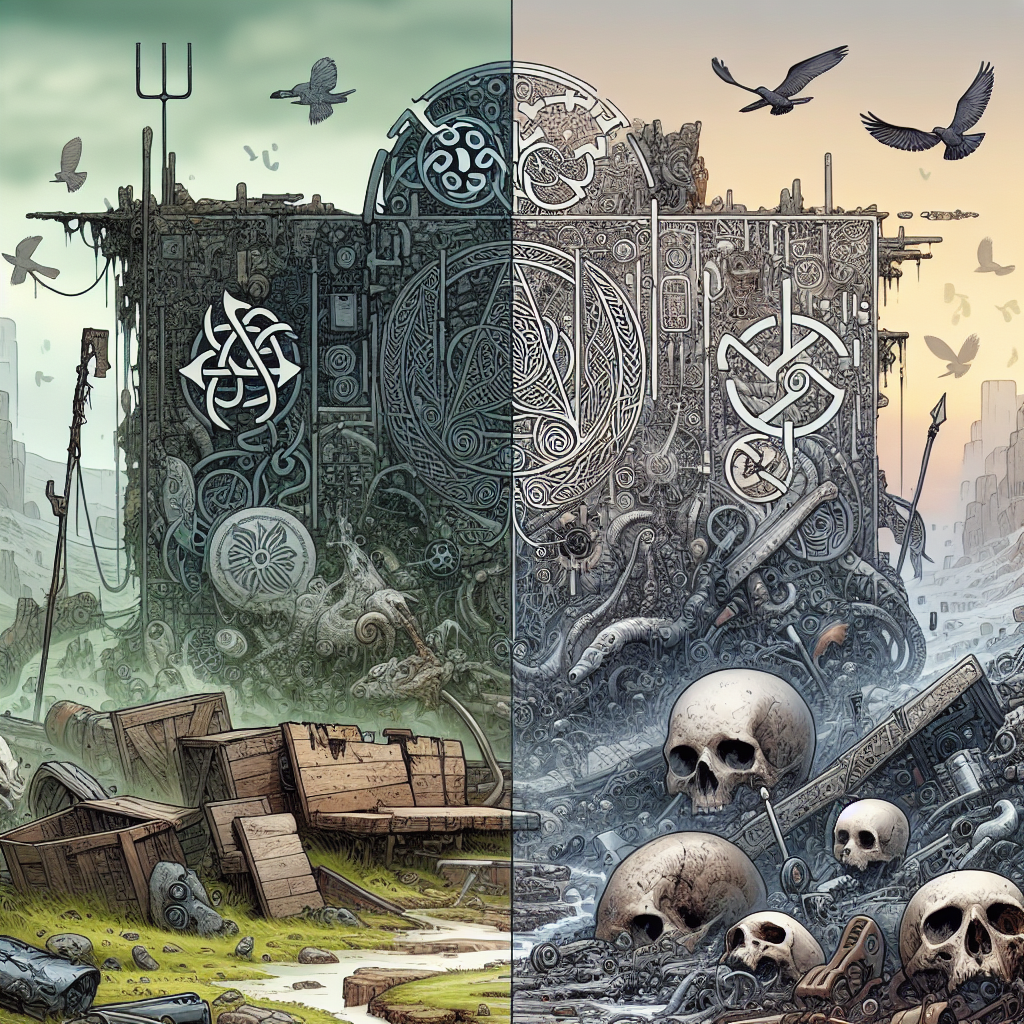When it comes to beliefs about the afterlife, Native American and Celtic cultures have distinct perspectives shaped by their spiritual beliefs, cultural perspectives, and ancestral traditions. While both cultures honor and connect with their ancestors, their views on the afterlife differ significantly. Native American beliefs often view the afterlife as a continuation of earthly existence, emphasizing ancestral connections and the importance of maintaining harmony with the natural world. In contrast, Celtic views center around an otherworldly realm of eternal happiness, separate from the mortal realm. These differences reflect the cultural richness and diversity of Native American and Celtic traditions.
Key Takeaways:
- Native American and Celtic views on the afterlife are shaped by their spiritual beliefs and cultural perspectives.
- Native Americans often see the afterlife as a continuation of earthly existence, while Celtic beliefs involve a separate otherworldly realm.
- Both cultures value ancestral traditions and honor their ancestors through rituals and ceremonies.
- Native American spirituality emphasizes the interconnectedness of all beings and the importance of maintaining harmony with the natural world.
- Celtic beliefs center around an otherworldly realm where eternal happiness is found.
Native American Afterlife Beliefs
Native American tribes hold diverse beliefs about the afterlife, shaped by their spiritual and cultural perspectives. These beliefs emphasize the interconnectedness of all beings and the continuation of life beyond death.
Some Native American tribes believe in the concept of reincarnation, where the soul is reborn into a new body after death. This belief reflects a cyclical view of life and death, where the soul has multiple opportunities for growth and learning. Other tribes view the afterlife as a spiritual journey to the ancestral realm, where ancestors guide and protect the living. This perspective emphasizes the importance of ancestral connections and the wisdom passed down from generation to generation.
In Native American spirituality, the afterlife is often seen as a continuation of earthly existence. It is a realm where balance and harmony with the natural world are essential. The interconnectedness of all beings is emphasized, and individuals are encouraged to honor and respect not only their ancestors but also the spirits of the land and the creatures that inhabit it.
Native American Afterlife Beliefs Summary:
- Beliefs about the afterlife vary among Native American tribes.
- Some tribes believe in reincarnation, while others see it as a spiritual journey to the ancestral realm.
- The afterlife is viewed as a continuation of earthly existence, emphasizing balance and harmony with the natural world.
- Ancestors and the spirits of the land are honored and respected in Native American spirituality.
Celtic Afterlife Beliefs
Celtic afterlife beliefs are deeply rooted in the mythology and folklore of ancient Celtic cultures. These beliefs center around the concept of an otherworldly realm, often depicted as islands or underground. Unlike Native American views, the Celtic afterlife is seen as a separate realm from earthly existence, a place of eternal happiness where there is no sickness, old age, or death. Celtic religious practices and rituals reflect the cultural perspectives and spiritual beliefs associated with the afterlife.
Central to Celtic afterlife concepts is the idea of a distinct realm inhabited by gods and spirits. In Celtic mythology, heroes embark on quests to this otherworld, encountering deities and engaging in symbolic journeys. These myths and legends provide insights into the Celtic worldview and their understanding of the afterlife. Rituals and customs associated with the afterlife, such as the veneration of sacred trees and the celebration of festivals like Samhain, demonstrate the cultural significance placed on the continuity of life beyond death.
Table: Contrasting Native American and Celtic Afterlife Beliefs
| Native American Afterlife Beliefs | Celtic Afterlife Beliefs |
|---|---|
| Continuation of earthly existence | Separate realm from mortal life |
| Focus on ancestral connections | Emphasis on eternal happiness |
| Reincarnation or journey to the ancestral realm | Heroes’ quests to the otherworld |
| Interconnectedness with the natural world | Distinct realm inhabited by gods |
| Importance of honoring ancestors and spirits | Veneration of sacred trees and celebrations |
The differences between Native American and Celtic afterlife beliefs reflect the unique cultural perspectives, religious practices, and ancestral traditions of these ancient civilizations. While both cultures value the continuity of life beyond death and the importance of ancestral connections, their understanding of the afterlife differs. Native American spirituality emphasizes the interconnectedness of all beings and the continuation of earthly existence, while Celtic spiritual beliefs focus on a separate realm of eternal happiness and hero quests to the otherworld.
Similarities in Spiritual Beliefs
Despite their unique cultural perspectives, Native American and Celtic traditions share commonalities in their spiritual beliefs regarding the afterlife. Both cultures recognize the significance of ancestral traditions, the importance of honoring and connecting with ancestors, and the existence of a spiritual realm or otherworld. These shared beliefs highlight the universal human need to find meaning and understanding in the concept of life after death.
In both Native American and Celtic cultures, ancestral traditions play a vital role in maintaining a spiritual connection with the deceased. Both traditions emphasize the wisdom and guidance that ancestors provide, and rituals and ceremonies are conducted to honor their memory. Through these practices, the living seek to maintain a link between the earthly realm and the afterlife, demonstrating the deep reverence for ancestral spirits.
Furthermore, both Native American and Celtic spiritual beliefs acknowledge the existence of a spiritual realm or otherworld. While the specifics may differ, both cultures recognize the presence of a supernatural dimension beyond the mortal realm. Native American tribes view the afterlife as a continuation of earthly existence, with a focus on harmony with nature. On the other hand, Celtic traditions envision a separate realm characterized by eternal happiness and the absence of suffering.
Table: Comparing Similarities in Spiritual Beliefs
| Beliefs | Native American | Celtic |
|---|---|---|
| Ancestral Connections | Emphasis on honoring and connecting with ancestors | Recognition of the wisdom and guidance of ancestors |
| Existence of a Spiritual Realm | View of the afterlife as a continuation of earthly existence | Belief in a separate realm of eternal happiness |
These similarities in spiritual beliefs between Native American and Celtic cultures demonstrate the profound impact of cultural perspectives and ancestral traditions on the understanding of the afterlife. Despite the differences in their specific beliefs and practices, both cultures share a fundamental desire to honor and connect with the spiritual realm and their ancestral heritage.
Ancestral Traditions and their Role in Native American and Celtic Afterlife Beliefs
Ancestral traditions hold a significant place in both Native American and Celtic afterlife beliefs, playing a crucial role in shaping their cultural perspectives, spiritual beliefs, and indigenous spirituality. These traditions serve as a vital link between the living and the deceased, helping to maintain a connection with ancestors and ensure a continued presence in the afterlife.
In Native American cultures, ancestral traditions emphasize the interconnectedness of past, present, and future generations. Ancestors are seen as guides and protectors, providing wisdom and guidance to the living. Practices such as ancestor veneration and storytelling are deeply ingrained in Native American spirituality, fostering a strong sense of connection and respect for those who came before. These traditions not only honor the memory of ancestors but also foster a deeper understanding and appreciation of the afterlife.
Similarly, Celtic cultures place great value on ancestral traditions, recognizing the wisdom and guidance of their predecessors. Celtic rituals and customs dedicated to honoring ancestors serve to maintain a spiritual connection with the afterlife. The veneration of sacred sites and the celebration of seasonal festivals, such as Samhain, provide opportunities for the living to connect with their ancestors and seek their blessings. Through these rituals, the memory and wisdom of the past are kept alive, ensuring a continued link to the afterlife.
| Native American Ancestral Traditions | Celtic Ancestral Traditions |
|---|---|
| Ancestor veneration | Ancestor veneration |
| Storytelling | Veneration of sacred sites |
| Connection with the natural world | Celebration of seasonal festivals |
| Guidance and wisdom from ancestors | Continued connection with the afterlife |
These ancestral traditions not only provide a sense of continuity between generations but also serve as a foundation for the spiritual beliefs and cultural perspectives of both Native American and Celtic communities. By upholding these traditions, these cultures maintain a deep reverence for the afterlife and the role that ancestors play in guiding and protecting the living.
The significance of ancestral traditions in Native American and Celtic afterlife beliefs cannot be understated. They serve as a bridge between the mortal realm and the world beyond, fostering a sense of connection, respect, and continuity with the afterlife. These traditions not only shape the cultural and spiritual perspectives but also provide a framework for understanding the mysteries of life beyond death.
Influence of Cultural Perspectives
Cultural perspectives play a significant role in shaping Native American and Celtic views on the afterlife. These perspectives influence spiritual beliefs, ancestral traditions, and indigenous spirituality, resulting in distinct interpretations of the concept of life beyond death.
In Native American cultures, the connection to the natural world is central to their spiritual beliefs. The belief in the interconnectedness of all beings resonates throughout their views on the afterlife. Native American tribes often perceive life and death as part of a cyclical nature, with the afterlife seen as a continuation of earthly existence. This perspective reflects the cultural significance placed on maintaining balance and harmony with the natural world.
In contrast, Celtic spirituality is deeply intertwined with mythology and folklore, which shape their cultural perspectives on the afterlife. Celtic traditions envision an otherworldly realm separate from the mortal realm, where eternal happiness and life exist. This distinct perspective is influenced by a rich tapestry of narratives depicting heroes embarking on symbolic journeys and encountering deities. Celtic religious practices, such as the veneration of sacred sites and the celebration of festivals, further highlight the importance placed on the afterlife.
These cultural perspectives provide unique lenses through which Native American and Celtic cultures understand and interpret the afterlife. While both perspectives honor ancestral traditions and recognize the spiritual significance of the afterlife, their specific beliefs and rituals reflect the diverse cultural heritage and spiritual practices of each tradition.
Spiritual Beliefs
| Native American | Celtic |
|---|---|
| View afterlife as a continuation of earthly existence | Believe in a separate otherworldly realm |
| Emphasize the importance of ancestral connections | Envision a realm of eternal happiness |
| Focus on maintaining balance and harmony with the natural world | Revere deities and mythical beings |
Differences in Religious Practices
Religious practices play a significant role in shaping the differences between Native American and Celtic views on the afterlife. These practices reflect the cultural perspectives, spiritual beliefs, and afterlife concepts of each culture.
NATIVE AMERICAN RELIGIOUS PRACTICES
Native American religious practices are deeply rooted in the connection to the spiritual realm and the honoring of ancestors. Ceremonies and rituals are conducted to seek guidance from spirits and ancestors, maintain harmony with the natural world, and ensure the well-being of the community. Sweat lodges, vision quests, and the use of sacred herbs are common practices that facilitate spiritual experiences and foster a sense of connectedness with the divine.
CELTIC RELIGIOUS PRACTICES
Celtic religious practices revolve around the veneration of sacred sites, such as stone circles and wells, and the celebration of seasonal festivals. These rituals are performed to honor the gods and ancestors, maintain a harmonious relationship with the natural world, and mark important transitions in the agricultural calendar. Offerings and prayers are made to seek blessings and ensure the prosperity and protection of the community.
| Native American Religious Practices | Celtic Religious Practices | |
|---|---|---|
| Beliefs | Emphasize connection to the spiritual realm and ancestral guidance | Focus on honoring gods and ancestors for blessings and protection |
| Ceremonies | Sweat lodges, vision quests, sacred herb usage | Veneration of sacred sites, seasonal festivals |
| Purpose | Seeking guidance, maintaining balance with nature | Honoring, seeking blessings and protection |
These differing religious practices highlight the unique cultural perspectives and spiritual beliefs regarding the afterlife in Native American and Celtic traditions.
Accounts from Mythology and Folklore
Mythology and folklore provide valuable insights into Native American and Celtic views on the afterlife. These stories and legends have been passed down through generations, carrying the cultural perspectives, spiritual beliefs, and afterlife concepts of these traditions.
In Native American mythology and folklore, there are numerous accounts of journeys to the spirit world and encounters with supernatural beings. These narratives convey important moral and spiritual lessons, highlighting the interconnectedness of the living and the deceased. They emphasize the idea that life continues beyond death, reflecting the deep-rooted belief in the continuity of existence.
Celtic mythology is rich with tales of heroes embarking on quests to the otherworld, where they encounter gods and experience symbolic journeys. These stories reflect the significance of the afterlife in Celtic cultural and religious traditions, portraying the otherworld as a realm of eternal happiness and divine beings.
The Importance of Mythology and Folklore
Mythology and folklore serve as a cultural treasure trove, preserving the beliefs, values, and traditions of Native American and Celtic peoples. They provide a glimpse into the spiritual worlds of these cultures, offering insights into how they perceived and understood the afterlife. These accounts often incorporate symbolic elements and narratives that resonate deeply with individuals, offering a sense of connection to their ancestral heritage and spiritual identity.
| Native American Mythology and Folklore | Celtic Mythology and Folklore |
|---|---|
| Depicts journeys to the spirit world | Features quests to the otherworld |
| Highlights the interconnectedness of the living and the deceased | Portrays the otherworld as a realm of eternal happiness |
| Conveys moral and spiritual lessons | Reflects the importance of the afterlife in Celtic traditions |
These accounts from mythology and folklore continue to captivate and inspire, offering a window into the profound and complex beliefs surrounding the afterlife in Native American and Celtic cultures.
Cultural Perspectives on the Afterlife
In both Native American and Celtic traditions, cultural perspectives play a significant role in shaping beliefs about the afterlife. These perspectives are influenced by a deep connection to ancestral traditions, spiritual beliefs, and religious practices. By examining these cultural perspectives, we can gain a deeper understanding of how Native American and Celtic cultures view the afterlife.
Native American Cultural Perspectives
Native American cultures have a strong appreciation for the interconnectedness of all beings and the continuity of life beyond death. They believe that the afterlife is a continuation of earthly existence, emphasizing the importance of maintaining balance and harmony with the natural world. Ancestral traditions hold a central place in Native American spiritual beliefs, with ancestors seen as guides and protectors. Ceremonies and rituals dedicated to honoring ancestors and connecting with the spiritual realm are an integral part of Native American culture.
Celtic Cultural Perspectives
Celtic cultures, on the other hand, view the afterlife as a separate otherworldly realm. This realm is depicted as a place of eternal happiness, free from sickness, old age, and death. Celtic mythology and folklore often feature stories of heroes embarking on quests to this otherworld, encountering deities and undertaking symbolic journeys. Sacred sites, such as stone circles and wells, hold great cultural significance in Celtic traditions and are venerated as portals to the afterlife.
| Native American Cultural Perspectives | Celtic Cultural Perspectives |
|---|---|
| Continuation of earthly existence | Separate otherworldly realm |
| Emphasis on maintaining balance and harmony with nature | No sickness, old age, or death in the otherworld |
| Importance of ancestral connections and honoring ancestors | Heroes embarking on quests to the otherworld |
While there are differences in cultural perspectives between Native American and Celtic views on the afterlife, both traditions share a deep reverence for ancestral wisdom and the spiritual realm. Festivals and celebrations are held to honor ancestors and connect with the afterlife, reflecting the enduring cultural significance of these beliefs. By understanding these cultural perspectives, we can gain a richer appreciation for the diversity and depth of Native American and Celtic afterlife traditions.

Contemporary Perspectives on the Afterlife
In modern times, Native American and Celtic afterlife beliefs continue to shape and evolve within the context of contemporary cultural and spiritual practices. These perspectives reflect the ongoing significance of the afterlife in these rich and diverse cultures.
Many Native American tribes maintain their ancestral traditions, incorporating them into everyday life and spirituality. The spiritual beliefs of Native American cultures have also influenced a broader cultural movement known as the New Age movement, which incorporates elements of indigenous spirituality and beliefs about the afterlife.
Similarly, Celtic spirituality has experienced a revival in recent years, with the emergence of neopagan movements such as Celtic neopaganism. These contemporary perspectives blend traditional beliefs with modern interpretations and practices, providing individuals with a sense of connection to their cultural heritage and spiritual beliefs surrounding the afterlife.
Contemporary perspectives on the afterlife in Native American and Celtic cultures serve as a testament to the enduring cultural and spiritual significance of ancestral traditions and indigenous spirituality. These perspectives continue to shape personal beliefs and provide individuals with a sense of connection to their roots and a deeper understanding of the afterlife.
| Aspect | Native American Perspectives | Celtic Perspectives |
|---|---|---|
| Ancestral Connection | Emphasis on honoring and connecting with ancestors through rituals and ceremonies. | Recognition of the wisdom and guidance of ancestors, with rituals dedicated to honoring their memory. |
| Spiritual Beliefs | Belief in the interconnectedness of all beings and the continuation of life beyond death. | Belief in a separate otherworldly realm of eternal happiness, distinct from the mortal realm. |
| Cultural Significance | Deeply rooted in the connection to the natural world, with a belief in the cyclical nature of life and death. | Shaped by rich mythology and folklore, featuring gods and symbolic journeys to the otherworld. |
Conclusion
The cultural perspectives, spiritual beliefs, and ancestral traditions of Native American and Celtic cultures shape their views on the afterlife. Native American traditions emphasize the interconnectedness of all beings and see the afterlife as a continuation of earthly existence. In contrast, Celtic beliefs envision a separate otherworldly realm of eternal happiness. Both cultures value their ancestors and maintain a strong connection with them through rituals and ceremonies.
These differing perspectives reflect the rich cultural and spiritual heritage of Native American and Celtic traditions. They highlight the universal human need to understand and find meaning in the concept of life after death. Despite their differences, both cultures share common elements such as the belief in a spiritual realm and the importance of honoring ancestors.
In contemporary times, these beliefs continue to evolve and influence modern practices. Native American spirituality has inspired the New Age movement, while Celtic spirituality has experienced a revival through neopagan movements. These contemporary perspectives blend traditional beliefs with modern interpretations, demonstrating the ongoing relevance of the afterlife in these cultures.
Overall, the differences between Native American and Celtic views on the afterlife reflect the unique cultural perspectives, spiritual beliefs, and ancestral traditions of each culture. They provide valuable insights into the diverse ways in which humans perceive and navigate the realms beyond life.
FAQ
What are the differences between Native American and Celtic views on the afterlife?
Native American beliefs view the afterlife as a continuation of earthly existence, emphasizing ancestral connections, while Celtic beliefs involve a separate otherworldly realm of eternal happiness.
What are some Native American afterlife beliefs?
Native American tribes have diverse beliefs, including concepts of reincarnation and a spiritual journey to the ancestral realm guided by ancestors.
How do Celtic afterlife beliefs differ from Native American beliefs?
Celtic afterlife beliefs involve a separate otherworldly realm of eternal happiness, distinct from the mortal realm, whereas Native American beliefs view the afterlife as a continuation of earthly existence.
Are there any similarities in the spiritual beliefs of Native American and Celtic cultures?
Yes, both cultures emphasize the importance of ancestral connections and the continuity of life beyond death.
What role do ancestral traditions play in Native American and Celtic afterlife beliefs?
Ancestral traditions serve to honor and maintain the spiritual connection between the living and the deceased in both Native American and Celtic cultures.
How do cultural perspectives influence Native American and Celtic views on the afterlife?
Cultural perspectives shape the rituals, ceremonies, and symbolic elements associated with the afterlife in both Native American and Celtic traditions.
How do religious practices differ between Native American and Celtic cultures?
Native American ceremonies often involve rituals to connect with and seek guidance from spirits and ancestors, while Celtic rituals include the veneration of sacred sites and the celebration of seasonal festivals.
What insights can be gained from mythology and folklore about Native American and Celtic views on the afterlife?
Mythology and folklore provide valuable insights into journeys to the spirit world, encounters with supernatural beings, and the interconnectedness of the living and the deceased in both Native American and Celtic cultures.
Why are festivals and celebrations significant in Native American and Celtic traditions?
Festivals and celebrations provide opportunities to honor ancestors, connect with the spiritual realm, and mark important transitions in the seasons in both Native American and Celtic cultures.
How do contemporary perspectives on the afterlife incorporate Native American and Celtic beliefs?
Contemporary perspectives blend traditional beliefs with modern interpretations and practices, reflecting the ongoing significance of the afterlife in both Native American and Celtic cultures.
 Skip to main content
Skip to main content


